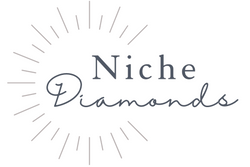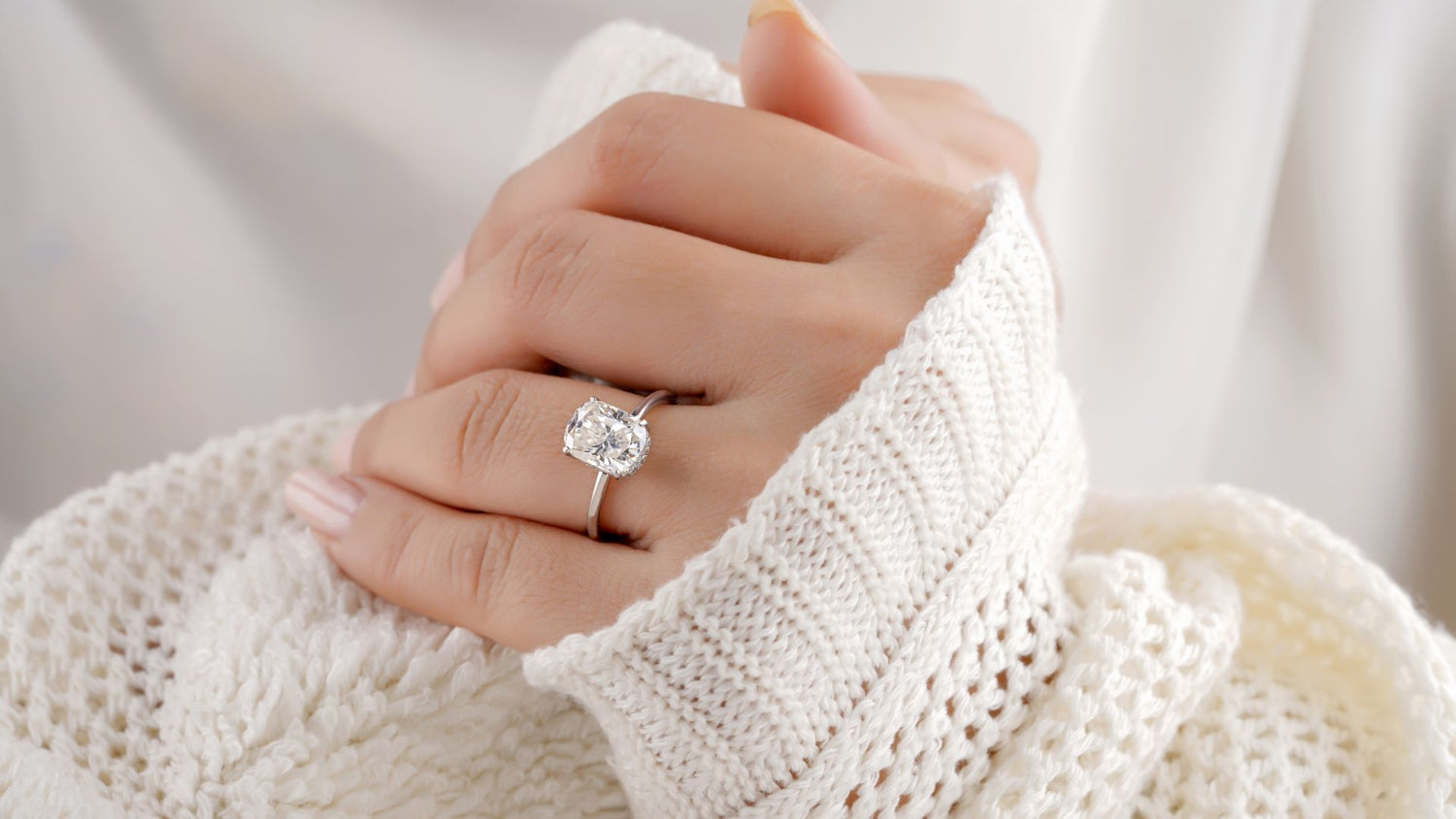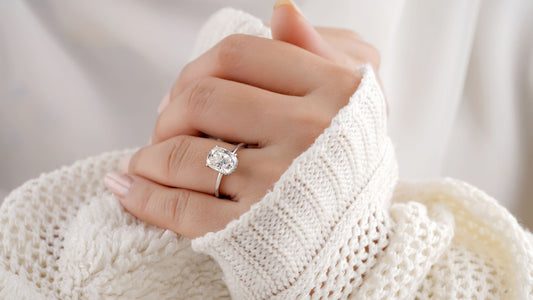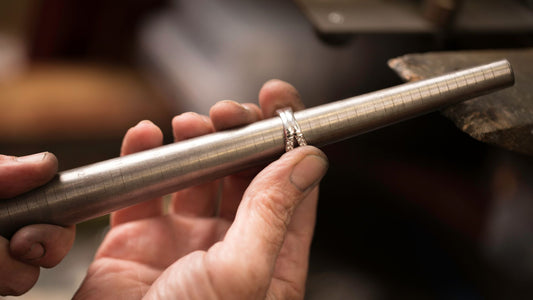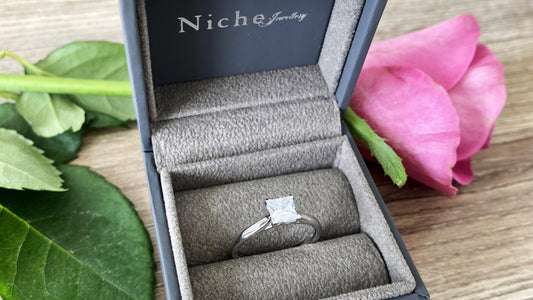Diamond terminology might seem like a foreign language. You've got your carats, cuts, and clarities – but what do they mean? And how can understanding these terms help you in choosing the perfect diamond engagement ring?
Parts of the Diamond
Before we tackle essential diamond terminology, here are the parts of the diamond you should know. Diamonds are made up of several distinct parts, each contributing to its overall appearance and allure. The main parts of a diamond include:
Crown
The crown is the top part of the diamond and consists of the table, which is the flat facet on the top, and the crown facets, which are the angled facets on the top portion of the diamond.
Pavilion
The pavilion, located at the bottom part of the diamond, comprises the culet, a small facet at the bottom tip, and the pavilion facets, which are the angled facets on the lower portion of the diamond.
Girdle
The girdle is the widest part of the diamond, where the crown and pavilion meet. It forms a band around the circumference of the diamond.
Culet
The culet is a small facet at the very bottom of the diamond. In older diamond cuts, the culet can be more prominent, while in modern diamonds, it is often a pointed tip rather than a faceted facet.
Table
The table is the large, flat facet on the top of the diamond, located on the crown. It is one of the most prominent facets and contributes significantly to the diamond's brilliance.

Diamond Shapes
There are different types of diamond shapes available. From the timeless elegance of the round brilliant cut diamond to unique fancy shapes, each shape has a distinct character. Choosing the right shape depends on personal style and the overall look one hopes to achieve. Here are some of the popular diamond shapes:
Round
The round shape is a classic choice and the most popular diamond shape due to its exceptional brilliance and versatility. It is known for its 58 facets that maximise sparkle.
Princess
The princess shape features a modern square profile with sharp corners. It is a popular choice for those seeking a contemporary and geometric look.
Emerald
The emerald shape showcases a step-cut faceting style with rectangular step-like facets. This shape highlights the diamond's clarity and is popular in vintage-inspired designs.
Pear
The pear shape combines a rounded end with a pointed tip, resembling a teardrop. It offers elegance and uniqueness and is often used in drop earrings and pendants.
Oval
The oval shape is a versatile choice that provides a flattering appearance on the finger. It has a similar brilliance to the round shape but with a more elongated profile.

Decoding the Four Cs of Diamond Terminology
No exploration of diamond terminology is complete without the 4Cs. These characteristics form the foundation of how diamonds are evaluated and valued.
Cut: Unlocking Brilliance
While most associate "cut" with a diamond's shape, it refers to the precision with which a diamond is faceted. Diamond cut is graded on a scale, with excellent cuts allowing light to bounce around and reflect through the top, maximising brilliance.
Depth Percentage
The depth percentage is an important characteristic of a diamond's cut, referring to the depth of the diamond compared to its width. The depth percentage is calculated by dividing the depth of the diamond by the diameter.
This characteristic affects how light is reflected through the diamond's structure. An ideal depth percentage will allow the light to reflect through the diamond, creating a bright and visually appealing sparkle. A poorly cut diamond with incorrect depth proportions will diminish the diamond's overall beauty and value.
This poorly cut diamond can appear dull even if it has high colour diamond and clarity grades. This is why understanding diamond cut quality is so important when selecting a diamond.
Table Percentage
The table percentage of a diamond is a characteristic of the cut and is the measurement of the table facet's size compared to the diameter of the diamond. A table facet is the flat surface on the top of the diamond.
The ideal table percentage varies based on the diamond shape and cut but falls between 50-58%. A well-cut diamond with the right proportion of table percentage will reflect light more effectively through the diamond, making it appear brighter and more attractive.
Colour: From Colourless to Fancy
When we talk about diamond colour, we are looking for the absence of colour. The less colour a diamond has, the rarer and more valuable it is.
The GIA Colour Scale grades diamonds from D (completely colourless) to Z (light yellow or brown). Fancy-coloured diamonds, with more saturated hues like pink, blue, or yellow, have their separate grading systems.
Interestingly, while a colourless diamond might seem ideal, some people prefer the subtle warmth of a diamond with a slightly lower colour grade like G or H. Ultimately, it's a matter of personal preference.
Clarity: Nature's Fingerprints
Almost all diamonds have tiny imperfections known as inclusions (internal flaws) or blemishes (external flaws). The number, size, position, and nature of these imperfections determine a diamond's clarity grade.
Diamonds free from inclusions are very rare and valuable. The GIA Clarity Scale ranges from Flawless (FL) to Included (I). Most diamonds used in jewellery fall somewhere in between, meaning the inclusions are generally not visible to the untrained eye.
When considering a diamond, remember that clarity characteristics are like tiny fingerprints, making each diamond one of a kind.
Carat Weight: A Matter of Size
Carat is the standard unit of measurement for a diamond's weight. Larger-carat diamonds are rarer and more expensive because they're found less frequently in nature than smaller diamonds.
Two diamonds of the same carat weight can have vastly different prices based on their cut, colour diamond, and clarity. This is why it is important to consider all of the four Cs when making a diamond purchase.
Beyond the 4Cs: Additional Diamond Terminology
While the four Cs lay the groundwork for understanding diamond terminology, additional factors greatly influence a diamond's beauty and value. Let's explore some other important diamond terminology.
Fluorescence
Some diamonds emit a soft glow when exposed to ultraviolet (UV) light, a phenomenon known as fluorescence. The strength and colour of fluorescence vary. The most common colour is blue.
Strong fluorescence can make a diamond appear hazy in natural light, so many prefer diamonds with faint or no fluorescence. Conversely, fluorescence can sometimes enhance the appearance of a diamond with a lower colour grade by making it look whiter.
Fire
Fire is a characteristic of diamonds and refers to the dispersion of light into the colours of the spectrum. The light entering a diamond becomes separated into different colours as it passes through the crystal structure. This phenomenon creates distinctive flashes of colour inside the diamond, which are visible from different angles.
The ability of a diamond to display fire is dependent on the cut's quality, where the proportion of angles and surfaces must be precise to maximise the effect. Fire is a unique and highly valued characteristic of diamonds, adding to their beauty and elegance.
Polish and Symmetry
Beyond cut, the polish and symmetry of a diamond impact its overall brilliance and light performance. Polish refers to the smoothness of the facets, while symmetry reflects how well-aligned those facets are.
These are important aspects of diamond terminology because even slight irregularities can affect the way light travels through the diamond. The girdle is the outer edge of the diamond and its thickness can affect its durability.
H&A (Hearts and Arrows) Pattern
The Hearts and Arrows pattern is a visual phenomenon that can occur in well-cut diamonds. If a diamond is cut with precise proportions and alignment, it can create a symmetrical pattern of eight hearts visible from the pavilion and eight arrows visible from the crown.
This pattern is indicative of an excellent cut and can enhance the diamond's overall beauty and brilliance. The H&A pattern is not visible in all diamonds, and a diamond cutter must have great skill and precision to create a diamond that displays Hearts and Arrows.
Diamond Certification
A diamond certificate, also known as a diamond grading report, from a reputable gemological laboratory, is beneficial for informed decision-making. Grading reports provide an unbiased evaluation of a diamond's four Cs and other characteristics.
Two of the most popular certification bodies are the Gemological Institute of America (GIA) and International Gemological Institute (IGI). Both are well respected diamond grading institutions and are well recognised worldwide.
GIA tends to be more popular in the USA, while IGI is also very popular in Europe and Asia. IGI often offers faster and cheaper certifications. Many diamonds purchased from a diamond dealer or retail jeweller will already come with either one of these certificates included and it's well worth taking a close look at the certificate provided with your diamond.
Find out more about diamond certification.
Natural Diamonds vs. Lab-Grown Diamonds
You may have heard of these two in diamond terminology. But what is the difference between natural diamonds and lab-grown diamonds?
Natural Diamonds
Natural diamonds are formed deep within the earth's mantle over millions or even billions of years. Their rarity and natural beauty have made them highly prized and sought after for centuries. The process of their formation under extreme heat and pressure gives them a unique and enduring quality.
These natural diamonds are known for their brilliance, fire, and lustre, which are admired for their ability to reflect light and create a mesmerising sparkle. Their scarcity naturally makes them more valuable, and they have long been associated with luxury, tradition, and romance.
Natural diamonds also have a strong investment value, as they have historically retained or even increased in value over time. Despite concerns about ethical practices in some mining areas, natural diamonds continue to be cherished for their authenticity, durability, and timeless appeal.
Lab-Grown Diamonds
Lab-grown diamonds, also known as synthetic or man-made diamonds, are created in a controlled laboratory environment using advanced technological processes. These diamonds have the same chemical and physical properties as natural diamonds, making them virtually indistinguishable.
One of the primary benefits of lab-grown diamonds is their affordability. They are usually priced considerably lower than their natural counterparts of comparable size and quality.
The ethical considerations surrounding lab-grown diamonds also make them an attractive option for those concerned about the environmental and social impact of diamond mining. The controlled environment of their creation allows for customisation, such as colour and clarity.
While the market for lab-grown diamonds is still developing, they offer a viable alternative for individuals looking for a more budget-friendly and ethically conscious choice without compromising on the beauty and durability of a diamond.
Make an Informed Decision When Buying Diamond Rings
Understanding diamond terminology can feel like unlocking a secret code, but it empowers you to make informed decisions when selecting a diamond. Remember, whether it's deciphering the four Cs, recognising fancy shapes, or appreciating the value of fluorescence, every aspect plays a role in shaping your ideal diamond.
Don't hesitate to use this knowledge, ask questions, and remember that each diamond tells a unique story, sparkling with both beauty and scientific wonder.
Ready to buy diamond rings? Niche Diamonds provides a selection of exquisite wedding and engagement rings, carefully designed to capture the essence of your love story. Whether you seek a classic solitaire ring or a bespoke design crafted with the assistance of our expert team, we offer a range of options to suit your preferences.
Discover a world of elegance and sophistication. Shop engagement rings from Niche Diamonds today!
